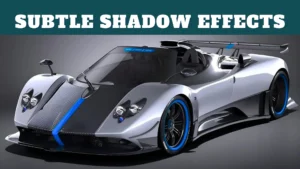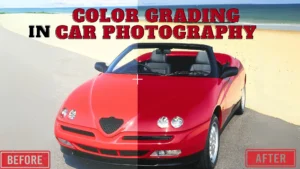In automotive photography, capturing the sleek lines, shiny paint, and intricate details of a car is crucial to creating stunning images that appeal to buyers. However, even with the best lighting and camera settings, a photo doesn’t always perfectly represent how a car looks in real life. This is where color correction comes into play. Color correction is an essential post-production process that ensures the colors in an image are true-to-life and as vibrant as possible. In this article, we’ll dive into the importance of color correction and how it enhances automotive photography. In this article, we will focus on the role of color correction in automotive photography.
Table of Contents
Toggle1. What is the Role of Color Correction?
Color correction is the process of adjusting the colors in a photograph to match how they appear in reality. Cameras, despite their sophistication, often don’t perfectly capture the colors we see with our eyes. Factors like lighting conditions, the camera’s white balance, or even reflections on a car’s surface can distort colors, making them look inaccurate or dull. Through color correction, photographers fine-tune the white balance, exposure, and individual color channels to make the colors in the image look natural and visually appealing.
In automotive photography, where buyers expect to see the exact color of the vehicle they are interested in, color correction is crucial. A car’s paint job is one of its most defining features, and ensuring that this color is accurately represented is key to creating trust between the buyer and the brand.
Key Takeaway
Color correction ensures that the colors in automotive images reflect real life, allowing potential buyers to see an accurate representation of the vehicle.
2. Correcting White Balance for Natural Lighting
One of the first role of color correction is adjusting the white balance of an image. White balance refers to how warm (yellow/orange) or cool (blue) the overall tone of the photo appears. Depending on the lighting conditions at the time of the shoot—whether outdoors in bright sunlight or indoors with artificial lighting—images can take on unwanted color casts. For example, an image shot in the shade might look too blue, while one taken under tungsten lighting may appear overly yellow.
Correcting the white balance ensures that the colors in the image appear more neutral and true to life. For automotive photography, this is especially important when it comes to accurately representing the car’s paint color. A blue car shouldn’t look purple, nor should a red car appear orange due to incorrect lighting conditions.
Key Takeaway:
White balance correction helps remove unwanted color casts from images, making sure the car’s color is presented accurately and naturally.
3. Bringing Out the True Color of Paint Jobs
One of the biggest selling points of any vehicle is its exterior paint. A car’s paint job, whether it’s a vibrant red, glossy black, or sleek metallic silver, needs to shine in photos just as it does in person. However, light reflection, shadows, and even the camera’s sensor can make the paint appear dull or inaccurate in photos.

Another notable role of color correction is enhance and bring out the true color of the vehicle’s paint. By adjusting saturation and contrast, they can make the color more vibrant without overdoing it. For example, the deep green of a sports car should look rich and alluring, while the pearlescent white of a luxury sedan should reflect light with sophistication.
Key Takeaway:
Color correction enhances the car’s paint job, ensuring it looks as vibrant and true-to-life in photos as it does in person.
4. Correcting Exposure and Contrast
Correct exposure is critical in automotive photography because it affects how light and dark areas in the image are displayed. Sometimes, due to challenging lighting conditions or reflections on the car’s surface, parts of the image may appear too bright (overexposed) or too dark (underexposed). Color correction helps in balancing these light and dark areas, ensuring the photo is properly exposed.
Contrast adjustments
Contrast adjustments another prominent role of color correction further refine the image by making sure there’s a clear distinction between different elements in the photo. High contrast can be used to make the car’s details pop, such as its headlights, rims, and grille. On the other hand, low contrast can soften an image when needed, like in luxury or lifestyle automotive shots where subtlety is key.
Key Takeaway: Color correction balances exposure and contrast, enhancing the car’s details and making the photo visually appealing.
5. Correcting Reflections and Light Flare
Cars, with their glossy exteriors and large reflective surfaces, often pick up unwanted reflections and light flares during photoshoots. These reflections, such as buildings, people, or even the photographer, can distort the appearance of the car and detract from the overall image.
Color correction can help minimize or eliminate these distractions by reducing their intensity or blending them more naturally into the background. By subtly toning down reflections or light flares, the car becomes the focal point of the image once again, allowing buyers to focus on its features rather than external distractions.
Key Takeaway:
Color correction reduces the impact of reflections and light flares, ensuring the car remains the primary focus of the image.
6. Enhancing Interior Shots with Precise Color
While exterior shots of a car are often the main attraction, interior images are just as important, especially for buyers who want to see the craftsmanship and features of the vehicle. However, interior shots can be tricky due to inconsistent lighting or shadows that make the car’s materials and colors appear washed out or inaccurate.
Color correction is used to adjust the tones within interior shots, ensuring that the leather, dashboard materials, and electronics look exactly as they should. For example, if a luxury vehicle has a black leather interior, the color should be deep and rich, not faded or gray. By balancing the light and enhancing the textures, photographers can make the interior of the car look luxurious and inviting.
Key Takeaway:
Color correction ensures that the car’s interior materials, textures, and colors are accurately portrayed, enhancing the overall appeal of the vehicle.
7. Setting the Mood with Color Grading
Once the basic color correction is complete, color grading can be applied to further enhance the overall mood or style of the image. While color correction ensures accuracy, color grading adds a layer of creative storytelling. For example, a sports car might benefit from a cooler, high-contrast color grade to give it a futuristic, high-performance feel. On the other hand, a classic car might use a warm, vintage color grade to evoke nostalgia.
By applying subtle tints, vignettes, or filters, photographers can make the car look more dynamic and exciting while maintaining the integrity of its features. Color grading helps match the vibe of the vehicle to the marketing message, whether that’s luxury, adventure, or cutting-edge technology.
Key Takeaway:
Color grading complements color correction by adding mood and atmosphere to the image, helping align the photo’s tone with the brand’s message.
8. Creating Consistency Across Marketing Campaigns
In automotive marketing, consistency is crucial, especially when multiple images of the same car model are used across different platforms or campaigns. Color correction ensures that every image, whether shot in different lighting conditions or at various angles, maintains a consistent look and feel. This uniformity helps build a strong brand identity and creates a cohesive experience for potential buyers, whether they are viewing the car in a catalog, on social media, or in an online advertisement.
Key Takeaway:
Consistent color correction throughout images helps build a strong, cohesive visual identity for automotive marketing campaigns.
Conclusion
Color correction is an indispensable tool in automotive photography that transforms raw images into polished, professional visuals. It ensures the car’s true colors shine through, corrects exposure and lighting issues, and removes unwanted distractions like reflections. With color correction, photographers can present vehicles in their best light, ensuring that potential buyers see an accurate and appealing representation of the car. As automotive marketing continues to evolve, color correction will remain critical in creating high-quality images that drive engagement and sales.










